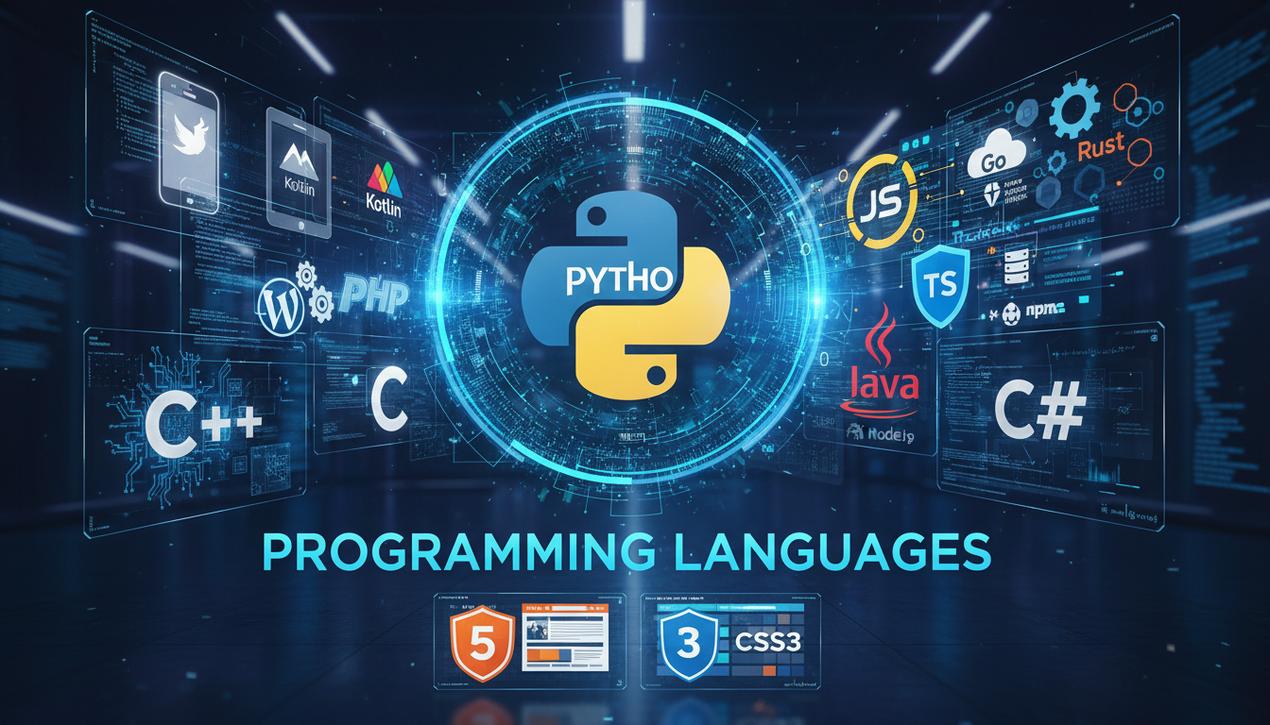Top 12 Programming Languages to Master in 2025


Diving into the world of development and learning to code can be daunting, especially for a beginner. With dozens of languages available, the initial question is often: where to begin? In 2025, choosing a programming language is more than a personal preference; it’s a strategic decision that can define a career path. The tech market is more dynamic than ever, with a surging demand for specialized skills in artificial intelligence, cloud computing, and interactive web development. Recent studies, such as the Stack Overflow Developer Survey, show that JavaScript and Python consistently dominate the landscape, used by over 65% and 50% of developers, respectively. Meanwhile, the TIOBE index highlights Python’s reign at the top, driven by the AI boom. This guide provides a detailed analysis of the 12 essential programming languages, based on current trends, market demand, and real-world use cases to help you make the right choice.
The Uncontested Leaders: The Top Tier in 2025
Three languages largely dominate the development ecosystem in 2025. Their versatility, vast communities, and critical importance in the most promising tech sectors make them safe and powerful choices for any developer.
1. Python: The Undisputed Leader
Launched in 1991, Python has seen exponential growth in recent years, consistently ranking at the top of indices like TIOBE. This dominance is largely due to its central role in the artificial intelligence (AI), machine learning, and data science revolution. Its clean, readable syntax emphasizes simplicity, making it an ideal starting point for beginners. But its simplicity is deceptive; Python is an extremely powerful language used by giants like Google, Netflix, and Spotify for tasks ranging from massive data analysis to recommendation algorithms. Its ecosystem of libraries, including TensorFlow, PyTorch, and Scikit-learn, is unparalleled for AI. Furthermore, with frameworks like Django and Flask, it is also a solid choice for back-end web development.
2. JavaScript: The Universal Language of the Web
If the web were a country, JavaScript would be its official language. According to the Stack Overflow survey, it has been the most commonly used programming language for over a decade. Originally designed to add interactivity to web pages, JavaScript is now ubiquitous. On the client-side (front-end), frameworks like React, Angular, and Vue.js are used to build complex and dynamic user interfaces. On the server-side (back-end), Node.js has revolutionized development by allowing JavaScript to be used for creating fast and scalable applications. Its massive ecosystem, managed via npm (Node Package Manager), provides access to millions of reusable packages. Mastering JavaScript is simply essential for anyone interested in modern web development.
3. TypeScript: The Superset That Scales JavaScript
TypeScript is a language developed by Microsoft that extends JavaScript by adding optional static typing. This feature helps catch many errors during the development phase, even before the code is run, making applications more robust, reliable, and easier to maintain, especially on large-scale projects. Its popularity has exploded, and it is now favored by millions of developers. All JavaScript code is valid in TypeScript, allowing for gradual adoption. Major frameworks like Angular are written entirely in TypeScript, and it is increasingly used with React and Vue.js. In 2025, learning TypeScript is a wise investment for any JavaScript developer looking to improve code quality.
Established Powerhouses: Still Relevant and in High Demand
These languages have proven their worth over decades. Their robustness, performance, and presence in critical systems ensure their continued relevance in the job market.
4. Java: The Pillar of Enterprise Applications
Created in the mid-1990s, Java remains a cornerstone of the corporate world thanks to its famous “Write Once, Run Anywhere” philosophy, made possible by the Java Virtual Machine (JVM). This portability, its robustness, and its mature ecosystem make it the language of choice for banking applications, large-scale management systems, and Big Data. Java is also the historical language for Android development, and although Kotlin is gaining ground, billions of devices still run on applications written in Java. Its performance and ability to handle complex systems ensure that Java developers will remain highly sought after for years to come.
5. C#: Versatility According to Microsoft
Pronounced “C-Sharp,” this language was created by Microsoft in the early 2000s as an alternative to Java. Tightly integrated with the .NET ecosystem, C# is a versatile and modern language. It excels at creating Windows desktop applications, robust back-end web services, and, most notably, in video game development. The Unity game engine, which powers a large portion of mobile and independent games, uses C# as its primary scripting language. It is an object-oriented language, relatively easy to learn for those with a basic understanding, and is supported by excellent development tools like Visual Studio.
6. C/C++: Performance in its Purest Form
C and C++ are the veterans of this list, but they are far from obsolete. These languages offer nearly complete control over hardware, giving them unparalleled performance. They are at the core of operating systems (Windows, Linux, macOS), web browsers, databases, and the most advanced game engines (like the Unreal Engine). C++ is indispensable in fields where every millisecond counts: high-frequency trading, embedded systems, IoT, and scientific modeling. Although their learning curve is steeper, mastering C or C++ opens the door to highly specialized and well-paid positions.
7. PHP: The Engine of the Dynamic Web
Despite the rise of new back-end technologies, PHP continues to power a massive portion of the web. It is estimated to be used on over 75% of websites, largely thanks to WordPress, the world’s most popular content management system. Far from the image it may have had in the past, PHP has become a modern, high-performing, and robust language, especially since versions 7 and 8. It remains a very relevant choice for web development, with a large community and an abundance of resources. For anyone working with WordPress, knowledge of PHP is essential.
Rising Stars: Languages to Watch Closely
These newer languages are rapidly gaining popularity by addressing modern challenges of security, performance, and cross-platform development.
8. Swift: The Future of Apple Applications
Created by Apple in 2014 to replace Objective-C, Swift is now the standard language for developing applications on iOS, macOS, iPadOS, watchOS, and tvOS. Designed to be safe, fast, and expressive, it has become the preferred choice for developers in the Apple ecosystem. Its modern syntax and built-in security features help reduce common errors. With Apple’s full commitment behind it, Swift is a must-know for mobile development on Apple platforms.
9. Kotlin: The Modern Choice for Android
In 2019, Google named Kotlin the official language for Android development. Fully interoperable with Java, it allows developers to gradually modernize their existing applications. Kotlin is prized for its concise syntax, which reduces the amount of code needed, as well as its safety features that help prevent common errors like null pointer exceptions. Its adoption is growing rapidly, and it represents the future of development on the world’s largest mobile platform.
10. Go (Golang): Simplicity Built for the Cloud
Developed by Google, Go (or Golang) was designed for building distributed systems and microservices, which are at the heart of cloud computing. It is distinguished by its simplicity, high performance, and native handling of concurrency (goroutines), which makes it easy to create programs that can perform multiple tasks simultaneously. Companies like Uber, Twitch, and Dropbox use it for their back-end infrastructure. It is an excellent choice for network applications and command-line tools.
11. Rust: The Guarantee of Safety and Speed
Voted the “most loved” language by developers on Stack Overflow for several consecutive years, Rust is gaining popularity for one major reason: it guarantees memory safety without using a garbage collector, giving it performance comparable to C++. Its unique “ownership” system eliminates entire categories of bugs at compile time. It is increasingly used for operating systems, game engines, and applications where security is paramount.
12. HTML & CSS: The Foundations of Every Web Page
Although they are not programming languages in the strict sense (they are markup and style languages), HTML and CSS are absolutely fundamental. HTML (HyperText Markup Language) provides the basic structure for all web content: text, images, links. CSS (Cascading Style Sheets) is used to control the visual appearance of that content: colors, fonts, layouts. Without a solid mastery of these two technologies, web development is simply impossible. The current version, HTML5, and advanced CSS3 features (Flexbox, Grid) are core skills for any web developer.
The landscape of programming languages in 2025 is rich and diverse. The “best” language does not exist in a vacuum; the optimal choice will always depend on your goals, the type of project you want to build, and the platforms you are targeting. Current trends clearly favor Python for AI, JavaScript and TypeScript for the web, and Swift/Kotlin for mobile. However, established languages like Java and C++ retain a crucial place in specific industries. The most important thing is to never stop learning, because technology is constantly evolving, and today’s skills are the foundation for tomorrow’s innovations.




